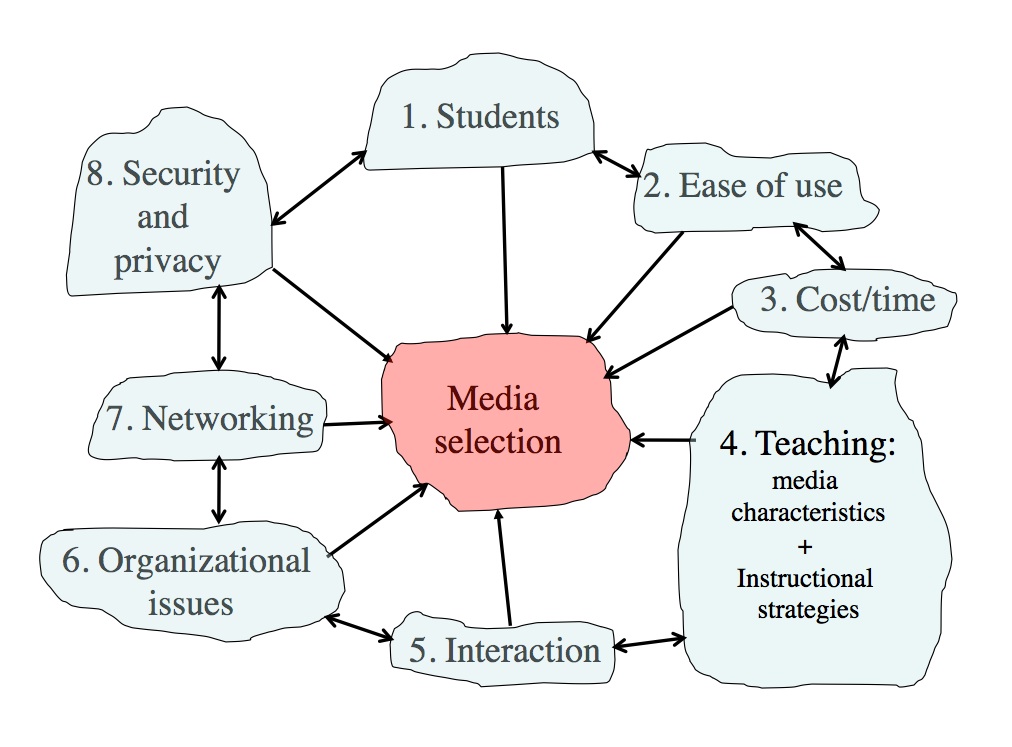
“Applying SECTIONS to the use of video in this course“
The SECTIONS Model is a useful framework that teachers may utilize to assess and evaluate the value of implementing a particular technology in their classrooms. SECTIONS is an acronym for eight distinct categories, including Students, Ease of Use, Costs, Teaching & Media, Interactivity, Organizational Issues, Networking, and Security & Privacy. Given the importance of digital literacy, inquiry, and creative thinking in the classroom, it is necessary for teachers to comprehend the value of utilizing digital technologies[1].
Answering the questions in the 8 categories of the SECTIONS model will allow us to apply the model to the usage of video in EDCI 337.
- Students: Students can easily and conveniently access video technology in the course by utilizing their own computers or the UVic ones. Some potential obstacles to using video in this course could be: some students’ lack of access to technology or the internet, which can be overcome by having them use UVic computers; and troubling video files, which can be overcome by teachers checking that the videos uploaded are in good working order.
- Ease of Use: The use of videos in this course is not a challenging topic. Without any particular knowledge or training, instructors can publish videos with ease, and students can easily use and access the video without requiring any skills. The use of video will also increase flexibility as students will be able to access it anytime they want.
- Costs: The use of video in this course won’t incur much expense. There are several simple-to-install and use free platforms for recording and editing video. It may take some time to record and edit video, but as the teachers have more practice, it gets quicker and simpler.
- Teaching: The use of video in the classroom has many advantages, such as flexibility because the video is always available and can be accessed by simply clicking; the use of subtitles for students for whom English is a second language to understand well; and the ability for students to watch the video at their own pace to help them comprehend clearly.
- Interaction: Different forms of engagement may be made possible by the use of video technology. For instance, students can watch a video about a certain subject covered in this course and then have a discussion about it among themselves. Additionally, comment sections on videos can be included to enable student interaction with the teacher and other students.
- Organization: Through help desk services in the library and other locations on campus, UVic offers assistance to instructors and students with regard to recording, editing, and accessing videos. Additionally, academic integrity and privacy regulations are enforced by Uvic.
- Networking: The use of video can easily widen networks and include more people in the course as everyone can access it wherever they are. Privacy risks can be managed by everyone adhering to school regulations and policies.
- Security: Video is a safe way to protect student and instructor privacy. When a teacher records a lecture, it is exclusively intended for instructional use only.
Given that the evaluation satisfies each condition of the SECTIONS model, I would obviously choose for using video in this course. Students benefit greatly from using videos in class because of its ease of use, flexibility, and security.

References:
[1] https://pressbooks.bccampus.ca/teachinginadigitalagev2/chapter/9-1-models-for-media-selection/ [2] https://www.youtube.com/watch?v=cwmo2NLBbkU
Hi Abdul,
I really enjoyed how you went over each part of the SECTIONS model and applied it to the use of video in this course. Something I am wodering after reading your post is which area of the SECTIONS model was the most difficult to evaluate? In your opinion do you think there were any areas that were harder to evaluate than others or do you think each area was equally the same in terms of evaluation.
Hi Max,
Thanks for the feedback. I think it was not that hard to do the SECTIONS model evaluation on video use in the EDCI 337 course, because video technology is something that is easy to use and does not require much cost. UVic already provides technology assistance to anyone who needs it.
Hi Abdul,
I also chose to write about SECTIONS because it stood out to me more than TPACK. I like your detailed clarification of SECTIONS with the use of videos in the course. I also chose to do that. It helps show readers the analysis and also which part would be lacking and requires strengthening. However, a cost problem would be possible when the videos are posted on YouTube and they show ads. The cost incurred now by students are extra time used on watching the ads. What do you think of this? I also believe that videos can widen network with the comments section for everyone to share their idea, controversy, and opinion. This does help a lot of growing a better perspective on the material.
Thanks,
Becky Zeng
Hi Becky,
I appreciate your feedback. That is correct; nonetheless, I believe that the majority of uploaded films will be private and free of adverts. However, if the teacher offers YouTube video links that have ads, we must pay for this in order to watch the video and gain more information. The solution could also be for students to download free ad blocks on chrome and watch videos without ads, that is what I normally do.
Thanks,
Abdul
Hi Abdul,
I appreciate the way you simplified and clarified SECTIONS – I totally agree that it helps comprehend teachers and students the value of utilizing digital technologies!
Interactions and ease of use are the most important for me – as a student that works full-time being able to watch videos on to go and interact with other students through the comment section has been such a great tool to still be in touch with individuals in my class. I find that interacting through the media actually helps me engage more with my classmates than going to class.